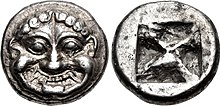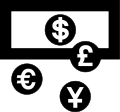Ancient Greek coinage


The history of ancient Greek coinage can be divided (along with most other Greek art forms) into four periods: the
Weight standards and denominations
The three most important standards of the ancient Greek monetary system were the

The obol was further subdivided into tetartemorioi (singular tetartemorion) which represented 1⁄4 obol, or 1⁄24 drachm. This coin (which was known to have been struck in Athens, Colophon, and several other cities) is mentioned by Aristotle as the smallest silver coin.[5]: 237 Various multiples of this denomination were also struck, including the trihemitetartemorion (literally three half-tetartemorioi) valued at 3⁄8 of an obol.[5]: 247
Archaic period (until about 480 BC)
The earliest known electrum coins,
In the middle of the 6th century BC, King Croesus replaced the electrum coins with coins of pure gold and pure silver, called Croeseids.[7] The credit for inventing pure gold and silver coinage is attributed by Herodotus to the Lydians:[8]
So far as we have any knowledge, they [the Lydians] were the first people to introduce the use of gold and silver coins, and the first who sold goods by retail.
— Herodotus, I.94[8]
The Greek world was divided into more than two thousand self-governing city-states (in Greek, poleis), and more than half of them issued their own coins. Some coins circulated widely beyond their polis, indicating that they were being used in inter-city trade; the first example appears to have been the silver stater or didrachm of Aegina that regularly turns up in hoards in Egypt and the Levant, places which were deficient in silver supply. As such coins circulated more widely, other cities began to mint coins to this "Aeginetan" weight standard of 6.1 g (3.9 dwt) to the drachm, other cities included their own symbols on the coins.
Athenian coins, however, were struck on the "Attic" standard, with a drachm equaling 4.3 g (2.8 dwt) of silver. Over time, Athens' plentiful supply of silver from the mines at
- International circulation
Archaic Greek coinage seems to have had a very wide circulation in the
-
ΦΑΝΕΩΣ(retrograde). Rev.: Two incuse punches, each with raised intersecting lines.
-
Athens coin (c. 500/490–485 BC) discovered in the Shaikhan Dehri hoard in Pushkalavati, Pakistan. This coin is the earliest known example of its type to be found so far east.[16]
Classical period (480–323 BC)
(circa 415–405 BC)
Obv.: head of the nymph Arethusa, surrounded by four swimming dolphins and a rudder
Rev.: a racing quadriga, its charioteer crowned by the goddess Victory
The Classical period saw Greek coinage reach a high level of technical and aesthetic quality. Larger cities now produced a range of fine silver and gold coins, most bearing a portrait of their patron god or goddess or a legendary hero on one side, and a symbol of the city on the other. Some coins employed a visual pun: some coins from Rhodes featured a rose, since the Greek word for rose is rhodon. The use of inscriptions on coins also began, usually the name of the issuing city.
The wealthy cities of Sicily produced some especially fine coins. The large silver decadrachm (10-drachm) coin from
Amongst the first centers to produce coins during the Greek colonization of mainland Southern Italy (Magna Graecia) were Paestum, Crotone, Sybaris, Caulonia, Metapontum, and Taranto. These ancient cities started producing coins from 550 to 510 BC.[17][18]
-
Aegina coin type, incuse skew pattern. Circa 456/445–431 BC.
-
Coin ofMacedon. Circa 470–430 BC.
-
Coin fromKorkyra. Circa 350/330–290/270 BC.
-
Coin of Cyprus, circa 450 BC.
Hellenistic period (323–31 BC)

The Hellenistic period was characterized by the spread of Greek culture across a large part of the known world. Greek-speaking kingdoms were established in Egypt and Syria, and for a time also in Iran and as far east as what is now Afghanistan and northwestern India. Greek traders spread Greek coins across this vast area, and the new kingdoms soon began to produce their own coins. Because these kingdoms were much larger and wealthier than the Greek city states of the classical period, their coins tended to be more mass-produced, as well as larger, and more frequently in gold. They often lacked the aesthetic delicacy of coins of the earlier period.

Still, some of the
The most striking new feature of Hellenistic coins was the use of portraits of living people, namely of the kings themselves. This practice had begun in Sicily, but was disapproved of by other Greeks as showing
The Hellenistic period conventionally ends with the
-
Ai Khanoum.[19]
-
Ai Khanoum.
-
Ai Khanoum.
-
Diodotus I (256–238 BC).
-
Diodotus II (235–225 BC)
-
Coin ofIndo-Greek king Antialcidas(105–95 BC).
-
Coin ofHindudeities, circa 180 BC.
-
Coin ofIndo-Greeks.
Minting

All Greek coins were
Coins as a symbol of the city-state
Coins of Greek city-states depicted a unique
Ancient Greek coins today

Collections of ancient Greek coins are held by museums around the world, of which the collections of the
There is also an active collector market for Greek coins. Several auction houses in Europe and the United States specialize in ancient coins (including Greek) and there is also a large on-line market for such coins.
Hoards of Greek coins are still being found in Europe, Middle East, and North Africa, and some of the coins in these hoards find their way onto the market. Due to the numbers in which they were produced, the durability of the metals, and the ancient practice of burying large numbers of coins to save them, coins are an ancient art within the reach of ordinary collectors.
See also
| Part of a series on |
| Numismatics the study of currency |
|---|
 |
- Art of ancient Greece
- Philippeioi
- Tetradrachm
- Silver stater with a turtle, early coin
Citations
- ^ BMC 11 - Attica Megaris Aegina
- ^ LSJ, cf: δράξ (drax), δραχμή (drachmē): grasp with the hand
- ^ "Obol". Retrieved 8 September 2014.
- ^ Figueira, "Iron Money and the Ideology of Consumption," Sparta: Beyond the Mirage (2002) 137–170
- ^ a b American Numismatic Society (1916). American Journal of Numismatics. Vol. 49–50. American Numismatic and Archaeological Society.
- ^ Classical Numismatic Group
- ^ ISBN 0691007365.
- ^ ISBN 9780199372188.
- S2CID 253075525.
- ^ a b Kagan, Jonathan. Archaic Greek coins East of the Tigris. pp. 230–234.
- ^ "a fragmentary stater of Thasos" described in Kagan p.230, Kabul hoard Coin no.9 in Daniel Schlumberger Trésors Monétaires d'Afghanistan (1953)
- ^ "a worn Chiot stater" described in Kagan p.230, Kabul hoard Coin no.12 in Daniel Schlumberger Trésors Monétaires d'Afghanistan (1953)
- ^ Kabul hoard Coin no.5 in Daniel Schlumberger Trésors Monétaires d'Afghanistan (1953)
- ^ CNG: ISLANDS off ATTICA, Aegina. Circa 510–490 BC. AR Stater (20 mm, 11.73 g).
- ^ "The 1933 Cabul hoard pub-lished by Schlumberger consisted of over 115 coins, with significant overlap with the Malayer hoard. Athens again is the largest group, with 33 recorded tetradrachms compared to eight sigloi. In addition to the worn archaic stater of Aegina, a fragmentary stater of Thasos and a worn Chiot stater may be archaic. There are two well-preserved early classical tetradrachms from Acanthus and an early classical stater of Corcyra. Again there is a significant Levantine component represented by coins from Pamphylia, Cilicia and Cyprus, though nothing from Phoenicia. The early Cilician coins probably date the hoard slightly later than the Malayer hoard." in Kagan, Jonathan. ARCHAIC GREEK COINS EAST OF THE TIGRIS. p. 230.
- ^ "A Truly International Currency", Triton XV, Lot: 1163, ATTICA, Athens Archived 2019-12-25 at the Wayback Machine, CNG Coins
- ^ "Bruttium - Ancient Greek Coins - WildWinds". Retrieved 8 September 2014.
- ^ "Lucania - Ancient Greek Coins - WildWinds.com". Retrieved 8 September 2014.
- ^ CNG Coin 338684
- ^ Grierson: Numismatics
- ^
Entry σέλινον at LSJ
- ^
Entry ῥόδον at LSJ
Further reading
- ISBN 0-19-885098-0
- Head, Barclay V. (1911), Historia Numorum; A Manual of Greek Numismatics, Oxford: Clarendon Press.
- Hill, George Francis (1906), Historical Greek Coins, London : Archibald Constable and Co.
- Jenkins, H.K. (1990), Ancient Greek Coins, Seaby, ISBN 1-85264-014-6
- ISBN 975-8070-61-4
- Kraay, Colin M. (1976), Archaic and Classical Greek Coins, New York: Sanford J. Durst, ISBN 0-915262-75-4.
- Melville Jones, John R, "A Dictionary of Ancient Greek Coins", London, Seaby 1986, reprinted Spink 2004.
- Melville Jones, John R, Testimonia Numaria. Greek and Latin texts concerning Ancient Greek Coinage, 2 vols (1993 and 2007), London, Spink, 0-907-05-40-0 and 978-1-902040-81-3.
- Ramage, Andrew and Craddock, Paul (2000), King Croesus' Gold; Excavations at Sardis and the History of Gold Refining, Trustees of the British Museum, ISBN 0-7141-0888-X.
- Rutter N. K, Burnett A. M, Crawford M. H, Johnston A. E.M, Jessop Price M (2001), Historia Numorum Italy, London: The British Museum Press, ISBN 0-7141-1801-X.
- Sayles, Wayne G, Ancient Coin Collecting, Iola, Wisconsin : Krause Publications, 2003.
- Sayles, Wayne G, Ancient Coin Collecting II: Numismatic Art of the Greek World", Iola, Wisconsin : Krause Publications, 2007.
- Seaford, Richard (2004), "Money and the Early Greek Mind; Homer, Philosophy, Tragedy", Cambridge: Cambridge University Press, ISBN 978-0-521-53992-0.
- Sear, David, "Greek Coins and Their Values: Volume 1", London: Spink, Seaby, ISBN 0 900652 462
- Sear, David, "Greek Coins and Their Values: Volume 2" London: Spink.
- Seltman, Charles (1933), Greek Coins, London: Methuen & Co, Ltd.
- Seltman, Charles, Masterpieces of Greek Coinage, Bruno Cassirer - Oxford, 1949.
- Thompson M, Mørkholm O, Kraay C. M. (eds): An Inventory of Greek Coin Hoards, (IGCH). New York, 1973 ISBN 978-0-89722-068-2
- Sylloge Nummorum Graecorum:
- American Numismatic Society: The Collection of the American Numismatic Society, New York
- Ward, John, Greek Coins and their Parent Cities, London : John Murray, 1902. (accompanied by a catalogue of the author's collection by Sir George Francis Hill)
- Hyla A. Troxell, Studies in the Macedonian Coinage of Alexander the Great, American Numismatic Society
External links
- Sylloge Nummorum Graecorum, website of Sylloge Nummorum Graecorum, a British Academy research project
- Coins from Cornell University's Collection of Antiquities
- Greek coins from Digital Library Numis (DLN)
- Coins from the Perseus Digital Library Project at Tufts University
- Historia Numorum Online
- Historia Numorum: A Manual of Greek Numismatics



















![Archaic coin of Thasos, c. 500–463 BC.[11]](http://upload.wikimedia.org/wikipedia/commons/thumb/f/f7/ISLANDS_off_THRACE%2C_Thasos._Circa_500-463_BC.jpg/120px-ISLANDS_off_THRACE%2C_Thasos._Circa_500-463_BC.jpg)
![Archaic coin of Chios, c. 490–435 BC.[12] Earlier types known.](http://upload.wikimedia.org/wikipedia/commons/thumb/c/ce/ISLANDS_off_IONIA%2C_Chios._Circa_490-435_BCE.jpg/120px-ISLANDS_off_IONIA%2C_Chios._Circa_490-435_BCE.jpg)
![Archaic Aegina coin type, "windmill pattern" incuse punch. c. 510–490 BC.[13][14][15]](http://upload.wikimedia.org/wikipedia/commons/thumb/f/fa/ISLANDS_off_ATTICA%2C_Aegina._Circa_510-490_BC.jpg/120px-ISLANDS_off_ATTICA%2C_Aegina._Circa_510-490_BC.jpg)
![Athens coin (c. 500/490–485 BC) discovered in the Shaikhan Dehri hoard in Pushkalavati, Pakistan. This coin is the earliest known example of its type to be found so far east.[16]](http://upload.wikimedia.org/wikipedia/commons/thumb/d/da/Athens_coin_discovered_in_Pushkalavati.jpg/120px-Athens_coin_discovered_in_Pushkalavati.jpg)






![Seleucus Nicator (312–281 BC), Ai Khanoum.[19]](http://upload.wikimedia.org/wikipedia/commons/thumb/5/5c/Seleucus_Nicator_Ai_Khanoum_mint.jpg/120px-Seleucus_Nicator_Ai_Khanoum_mint.jpg)














